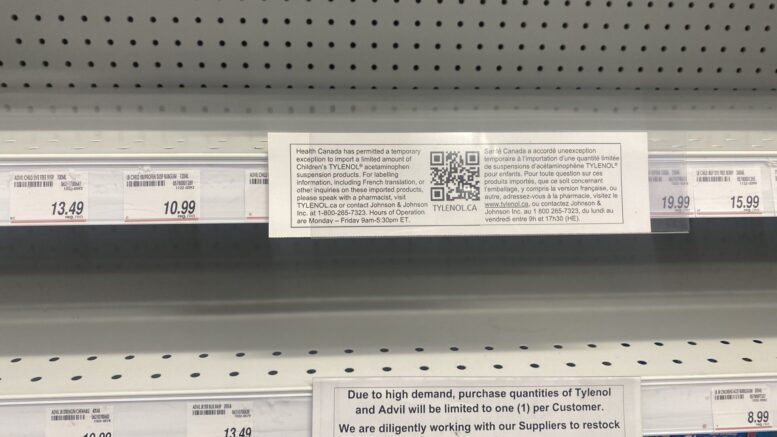Parents in East York say they are desperate for children’s Tylenol, amid a “multi-demic” of respiratory infections like Respiratory syncytial virus (RSV), flu, bacterial pneumonia, COVID-19 and asthma.
Drug-store shelves that usually stock the pain reliever have been empty for months, due to ongoing supply-chain issues. And now, increasing demand from parents, who are also stockpiling the meds, is also driving the shortage, the chief pharmacist officer at the Canadian Pharmacists Association told CTV.
“In the summer, when my friend told me there is a shortage of pain meds for kids, I laughed it off, thinking that it couldn’t be true in a first-world country. Boy, was I wrong,” said Nora Schramek-Loebell, an East York mom.
Schramek-Loebell said her experience looking for children’s medications has been “bonkers.”
“My three kids have been on and off sick for eight weeks now,” she said. “I’ve hunted for meds all over the city. I went to walk-ins and stood in line for ages to get a prescription.”
Some parents are resorting to adult Tylenol to break their children’s fever.
“I’ve gone to many different pharmacies and haven’t been able to find children’s Tylenol anywhere. Thankfully, my pharmacist told me that my son’s weight is high enough that he can use regular adult Tylenol tablets crushed up in applesauce.” Brittany Amanda, another East York mom, said.
Health Canada: Don’t use adult meds for kids
However, that was not the case for her friend. Amanda said her friend finally “got a prescription from a doctor and had to pay $70 for a bottle for her sick son. I think that’s beyond unacceptable in a country like Canada. There are many people who wouldn’t be able to afford that. It’s scary.”
In a public advisory release, Health Canada says they recognize that “this situation is concerning and how important these health products are for families, caregivers and health care professionals who rely on them to reduce fever and pain in infants and children.”
Health Canada also offered a list for parents on what should be done as alternatives. Among the list, they advised against using adult fever medicine for children under 12, and to speak to health-care professionals, such as pharmacists, to seek alternatives.
When will the shortage end?
In an Oct. 7 update on supply of children’s acetaminophen and ibuprofen products, Health Canada said they have been in direct contact with manufacturers to ramp up production and explore strategies to alleviate the situation, but the demand continues to outpace the supply.
In a press conference Nov. 18, Health Canada’s chief medical adviser, Supriya Sharma, said that foreigner imports have been approved to supply Canada’s shortage and will be distributed across the country. Additionally, more than one million bottles are entering the country this week, and will be distributed intermittently to hospitals, pharmacies and retailers. Dr. Sharma said Health Canada will continue to carefully assess proposals received to increase supply.
Children’s Amoxicillin, an antibiotic, is also facing shortages across Canada, but Dr. Sharma said Health Canada is working with the Canadian Paediatric Society and manufacturers to get more supply.
Canada’s bilingual requirement for packaging was blamed as the reason for not being able to import from countries like the U.S. and Australia. However, Dr. Sharma said regulators have waived those requirements in efforts to speed up production.
Emergency rooms are full
The shortage of children’s medicine has caused concerned parents to go to emergency rooms, which in turn has caused an unprecedented surge for demand for healthcare services and long wait times. Hospitals across the country have been running on overcapacity.
Earlier in November, Michael Garron hospital in East York posted a news release warning people of long wait times, and what they should do before coming to the emergency room. SickKids hospital also posted a news release warning parents of long wait times and the high volumes of patients. They advised people to bring water bottles, entertainment, phone chargers, snacks and blankets with them to the ER.
What else can be done?
Medical historian Dr. Jacalyn Duffin said the drug shortage problem is not a recent issue, but a long-term vulnerability to Canada’s drug supply. “The shortages of Tylenol and Advil are just the tip of the iceberg, and those shortages have been going on for more than a decade in Canada,” she said. “The supply chain has been very fragile for years.”
Duffin, who manages CanadaDrugShortage.com, a website dedicated to tracking drug shortages, attributes the shortages to 17 possible causes.
“We need transparency about where the drugs are coming from. We need an essential medicine list to know which are most important and which are the most vulnerable. We need to be measuring it properly, we need those companies to report all their shortages.”

